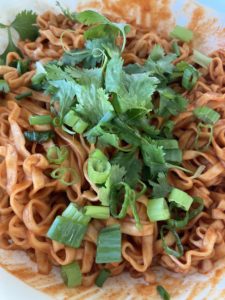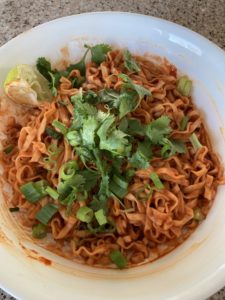
I have written before about my love of Korean food. The cuisine delivers spice, complexity and a little sweetness. It lends itself well to carnivores and vegetarians alike, and with the right ingredients is quite simple to make.
When cooking Korean-style, I lean heavily on gochujang, which is a delightful blend of chili powder, sticky rice, salt and fermented soybean powder — a glorious red paste that makes everything taste good. Gochujang is increasingly available in traditional supermarkets, but if you can’t find it, order it online or head to your local Asian grocery or to Chinatown to secure a supply.
We tossed together a delicious dish of spicy noodles to accompany some grilled chicken and zucchini, but the following recipes can be used with any protein or vegetable that you like.
Korean-Style Gochujang Noodles
Serves 2
A note on the noodles: I bought dry, packaged ramen from my local shop, but any noodle works here — fresh, dry, rice-based, even “zoodles” or spiralized veggies. Use egg noodles or spaghetti if that is all you have on hand.
1 8-ounce package dry ramen-style noodles
2 tablespoons gochujang paste
1 teaspoon rice vinegar
1 teaspoon soy sauce
1 teaspoon sesame oil
1 small handful fresh cilantro, coarsely chopped
1 scallion, white and green parts, chopped
In a medium-sized bowl, mix the gochujang, vinegar, soy sauce and sesame oil.
Cook the noodles according to the package directions until just al dente. Drain the noodles, reserving ¼ cup of cooking water. Toss the noodles in the sauce and, if needed, add a little bit of the hot water to distribute (you should not need all of the water). Sprinkle the noodles with the cilantro and scallions, and serve immediately.
 Grilled Whatever …
Grilled Whatever …
This marinade is wonderful on pretty much any protein: flank steak, chicken, salmon, tuna or tofu. For steak or chicken, you can let it soak for several hours or overnight; fish and tofu need less time to absorb the flavor — an hour tops. For fish especially, you don’t want to overdo it or the texture will break down, and that is not what you are after.
This recipe covers about three-quarters of a pound of protein, which will feed two; it is easily multiplied for a larger crowd.
1-inch piece of ginger root, grated
2 cloves garlic, minced
2 tablespoons canola oil or other mild oil
1 tablespoon soy sauce
1 teaspoon sugar or honey
1 tablespoon mirin (or substitute sake, marsala wine or sherry)
¼ cup water
Mix all the marinade ingredients, and use as desired.
Zucchini with Seoul
Serves 2
As local zucchini is starting to come into markets and gardens, a few interesting recipes for this squash are a cook’s friend this time of year. The traditional version of this dish uses a salted shrimp paste, but I have adapted it to the Exponent audience with the substitution of miso paste. If you don’t have (or don’t like) zucchini, any vegetable can be used here.
Just be sure to alter the cooking time to suit what you are sautéing. For example, spinach cooks very quickly, but carrots need more time in the pan.
1 large or two small zucchini, cut in half lengthwise, then sliced to make half circles
1 tablespoon canola oil
2 teaspoons miso paste (any type)
2 cloves garlic, minced
1 scallion, white and green parts, sliced
1 teaspoon sesame oil
1 teaspoon sesame seeds
Heat the oil in a skillet with garlic until fragrant; add the zucchini and miso paste and cook for a few minutes. If the zucchini and garlic begin to stick, add a teaspoon or two of water.
Add the remaining ingredients, and cook until zucchini is softened but not mushy.
Serve hot or at room temperature.



